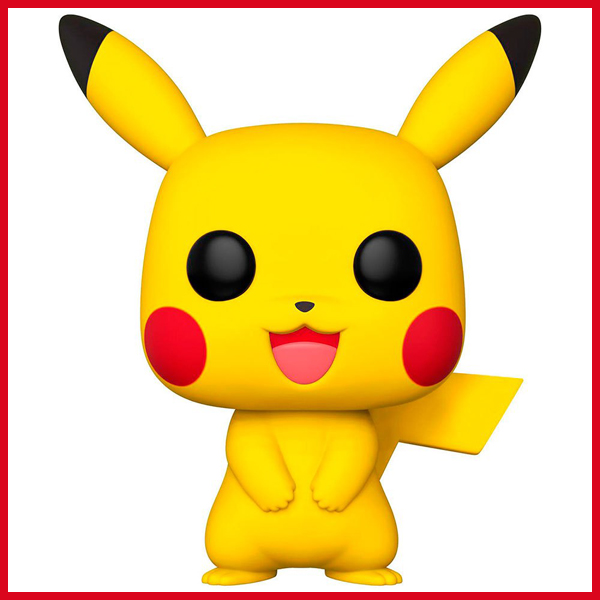:::::::::::::::::::::::::::::::::::::::::::::::::::::::::::::::::::::::::::::::::::::::::::::::::::::::::::::::::::::::::::::::::::::::::::::::::::::::::::::::::::::::::::::::::::
Pokemon ポケモン Pocket Monsters
- quote
Pokémon (an abbreviation for Pocket Monsters in Japan)
is a Japanese media franchise managed by The Pokémon Company, a company founded by Nintendo, Game Freak, and Creatures.
The franchise was created by Satoshi Tajiri in 1996, and is centered on fictional creatures called "Pokémon".
In Pokémon, humans, known as Pokémon Trainers, catch and train Pokémon to battle other Pokémon for sport. All media works within the franchise are set in the Pokémon universe. The English slogan for the franchise is "Gotta Catch ‘Em All!".
There are currently 905 Pokémon species.
The franchise began as Pocket Monsters: Red and Green (later released outside of Japan as Pokémon Red and Blue), a pair of video games for the original Game Boy handheld system that were developed by Game Freak and published by Nintendo in February 1996.
It soon became a media mix franchise adapted into various different media. Pokémon is estimated to be the highest-grossing media franchise of all time. The Pokémon video game series is the fourth best-selling video game franchise of all time with more than 380 million copies sold and one billion mobile downloads.
The Pokémon video game series spawned an anime television series that has become the most successful video game adaptation of all time with over 20 seasons and 1,000 episodes in 183 countries. The Pokémon Trading Card Game is the highest-selling trading card game of all time with over 34.1 billion cards sold.
In addition, the Pokémon franchise includes the world's top-selling toy brand, an anime film series, a live-action film (Detective Pikachu), books, manga comics, music, merchandise, and a temporary theme park. The franchise is also represented in other Nintendo media, such as the Super Smash Bros. series, where various Pokémon characters are playable.
- - - More in the WIKIPEDIA !
:::::::::::::::::::::::::::::::::::::::::::::::::::::::::::::::::::::::::::::::::::::::::::::::::::::::::::::::::::::::::::::::::::::::::::::::::::::::::::::::::::::::::::::::::::
-source : M.Lucero -
Yokai: The Folklore Roots of Pokémon
Kappa - Lombre
Tengu - Shiftry
Kotengu - Nuzleaf
Futakuchi Onna - Mawile
Kyubi no Kitsune fox - Ninetales
Amikiri to cut nets - Gligar
Sazae Oni - Slowbro / sazae snail (Turbo cornutus)
Baku - Drowzee
Jinmenju, or ninmenju - Exeggutor
Yamanba, Yamamba - Jynx
Nekomata cat - Espeon
Kamaitachi, Kama Itachi “sickle weasel" - Sneasel
Chochin Obake - Dusclops
Kirin - Suicune
Yuki warashi, Yukinbo - Snorunt
Hakutaku - Absol
Ho-O, hō-ō, hōō - Ho-Oh
Tsuchinoko - Dunsparce
Tatsu (Dragon) - Rayquaza
Wani (dragon-like monster) - Gyarados
Basan (chicken) - Magmar
Tanuki (badger) - Zigzagoon
Ungaikyo 雲外鏡 (mirror) - Bronzor
Yuki onna (snow woman) - Froslass
Fujin (God of Wind) - Tornadus
Raijin (God of Thunder) - Thundurus
Sogenbi (fire head) - Gastly
Matthew Meyer’s own website, - yokai.com -
is a highly-recommended, thoroughly-researched guide to the monsters, ghosts, and creatures of Japanese folklore.
His images are with permission of the artist.
.......................................................................
Jinmenju じんめんじゅ – The Human Face Tree
This tree is found in mountain valleys. The fruit of the tree looks like a human head. It doesn’t say a word, but it is constantly laughing. It is said that if the fruit laughs too heartily, it falls from the tree.
According to the Edo period Hyakka Jiten encyclopedia Wakan Sansai Zue (和漢三才図会;
A Collection of Pictures of Heaven, Earth, and Man from China and Japan),
the Jinmenju trees are found in the south, and the fruit of the tree is called the jinmenshi, or human-faced child. They ripen in the fall, and if you eat the fruit they have a sweet/sour taste. It is said that the Jinmenju seed also has a human face, eyes, ears, nose, and mouth. It is possible that the trees were all eaten and it is why we don’t see them today.
In the past however, it was said that people planted great orchards of the laughing Jinmenju. That must have been a beautiful sight.
The legend of the Jinmenju comes from China, and was passed onto Japan where it was considered to be a yokai due to its peculiar nature. There are also stories of trees bearing human-faced fruit from India and Persia, usually with the faces of beautiful girls. Even now, when you walk through the forest you can see trees whose roots bear a resemblance to human and yokai faces.
- source : facebook Japanese.Ghosts ... -
:::::::::::::::::::::::::::::::::::::::::::::::::::::::::::::::::::::::::::::::::::::::::::::::::::::::::::::::::::::::::::::::::::::::::::::::::::::::::::::::::::::::::::::::::::

. - - - Join my Yokai friends on facebook ! - - - .
:::::::::::::::::::::::::::::::::::::::::::::::::::::::::::::::::::::::::::::::::::::::::::::::::::::::::::::::::::::::::::::::::::::::::::::::::::::::::::::::::::::::::::::::::::
- Yōkai 妖怪 Yokai monsters - - ABC-Index -
. yookai, yōkai 妖怪 Yokai monsters .
- Reference -
. Legends and Tales from Japan 伝説 - Introduction .
. Kappa densetsu 河童伝説, Kappa minwa 河童民話 - Legends - Introduction .
. Tengupedia - 天狗ペディア - Tengu ABC-List .
. Mingei 民芸 Regional Folk Art from Japan .
:::::::::::::::::::::::::::::::::::::::::::::::::::::::::::::::::::::::::::::::::::::::::::::::::::::::::::::::::::::::::::::::::::::::::::::::::::::::::::::::::::::::::::::::::::
[ . BACK to DARUMA MUSEUM TOP . ]
[ . BACK to WORLDKIGO . TOP . ]
- ##pokemon #pocketmonster #monster #yokai -
:::::::::::::::::::::::::::::::::::::::::::::::::::::::::::::::::::::::::::::::::::::::::::::::::::::::::::::::::::::::::::::::::::::::::::::::::::::::::::::::::::::::::::::::::::

















































